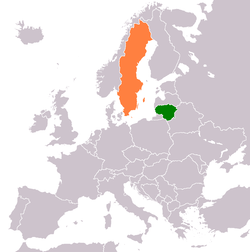Lithuania–Sweden relations
 |
|
Lithuania |
Sweden |
|---|---|
Lithuania–Sweden relations are the foreign relations between Sweden and Lithuania. Sweden has an embassy in Vilnius. Lithuania has an embassy in Stockholm.
Official visits
In 2001, Lithuanian President Valdas Adamkus visited Stockholm to discuss Lithuania’s integration into the European Union and further co-operation of the two states.[1]
In February 2009, Lithuanian Prime Minister Andrius Kubilius met with Prime Minister of Sweden Fredrik Reinfeldt in Stockholm. The Prime Ministers discussed energy projects of Lithuania and the Baltic States, the situation in the financial markets of Lithuania, Sweden, Europe, and the world. The Swedish Prime Minister also confirmed that the Swedish Government was greatly interested in the stability of the Lithuanian and the Baltic economies and was going to further encourage long term investment by Swedish banks to Lithuania’s economy.[2]
In July 2009, President of Lithuania Dalia Grybauskaitė made her first visit to Sweden. She met with Swedish Prime Minister Reinfeldt[3] as well as executives from Swedish banks SEB and Swedbank to discuss the economic situation in Lithuania.[4]
Agreements
In 1991, the two countries signed a trade agreement.[5]
In January 2000, the two countries signed an agreement on safety enhancement at nuclear plants.[6] In March the same year, the two countries signed a nuclear safety cooperation agreement.[7]
In 2005, the two countries together with Russia signed an agreement on exclusive economic zones on the Baltic Sea continental shelf. The economic zones meet in the Dutch Trench, 141 km from the coastline. The new border falls approximately 1.5 km short of the demarcation line under the 1988 agreement between the Soviet Union and Sweden.[8]
Cooperation
The Swedish Chamber of Commerce in Lithuania was started as Swedenhouse in 2001 and was converted into a Chamber of Commerce in 2005.[9]
In 2007, Lithuanian energy company Lietuvos Energija and Sweden's Svenska Kraftnat announced they were considering a possible linking of the two countries' energy grids.[10] This resulted in the two companies signing a memorandum of understanding with Latvenergo from Latvia in 2009. Due to be completed in spring 2016, the project aims at building a link - a cable of approximately 350 km in length across the bottom of the Baltic Sea, and converter stations to connect electric power transmission systems of Lithuania and Sweden. A preliminary total cost of the project is between EUR 516-738 million.[11]
See also
References
- ↑ http://adamkus.president.lt/en/one.phtml?id=2297
- ↑ http://old.lrv.lt/main_en.php?id=en_aktualijos_su_video/p.php&n=1108
- ↑ http://www.washingtonpost.com/wp-dyn/content/article/2009/07/16/AR2009071600995.html
- ↑ http://www.baltic-course.com/eng/baltic_states/?doc=15882
- ↑ http://untreaty.un.org/unts/60001_120000/29/23/00057150.pdf
- ↑ http://nl.newsbank.com/nl-search/we/Archives?p_product=NewsLibrary&p_multi=BBAB&d_place=BBAB&p_theme=newslibrary2&p_action=search&p_maxdocs=200&p_topdoc=1&p_text_direct-0=0F97D7C7D9585078&p_field_direct-0=document_id&p_perpage=10&p_sort=YMD_date:D&s_trackval=GooglePM
- ↑ http://nl.newsbank.com/nl-search/we/Archives?p_product=NewsLibrary&p_multi=BBAB&d_place=BBAB&p_theme=newslibrary2&p_action=search&p_maxdocs=200&p_topdoc=1&p_text_direct-0=0F97D8E85AE3E44E&p_field_direct-0=document_id&p_perpage=10&p_sort=YMD_date:D&s_trackval=GooglePM
- ↑ http://nl.newsbank.com/nl-search/we/Archives?p_product=NewsLibrary&p_multi=BBAB&d_place=BBAB&p_theme=newslibrary2&p_action=search&p_maxdocs=200&p_topdoc=1&p_text_direct-0=10E3BA594A687978&p_field_direct-0=document_id&p_perpage=10&p_sort=YMD_date:D&s_trackval=GooglePM
- ↑ http://www.swedish.lt/about-us/history
- ↑ http://www.forbes.com/feeds/afx/2007/02/06/afx3398309.html
- ↑ http://www.euroinvestor.co.uk/news/story.aspx?id=10529382
